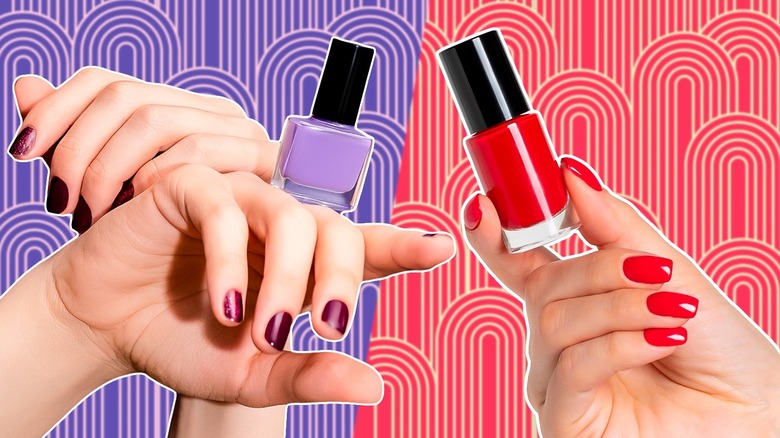The Difference Between Nail Lacquer And Polish, Explained
Since what feels like nearly the beginning of time, humans have felt the urge to use their fingernails to express themselves via tints and colors. Ancient Chinese rulers once ground colorful flowers with other natural ingredients like eggs and beeswax to stain their nails in reflection of their high societal stature. These high-class recipes eventually morphed into colored powder concoctions that would be buffed (aka polished) onto nails to tint them.
In the early 1920s, Revlon released the first liquid chemical version of what is now known as nail polish in the U.S. using ingredients borrowed from automotive paint, as per Sienna. While the formula was reportedly less than kind to fingernails, it did open the floodgates for the nail polishes and lacquers we know and love today. One distinction that remains largely a mystery, however, is the exact difference between the two. As it turns out, these nail products are even more similar than you might have first thought — it all comes down to simple consistency.
What is nail polish?
While nail polish has evolved a great deal since the days of buffed-in powder tints, the term "nail polish" remains unchanged. By today's standards, nail polish and its successor — nail lacquer — are mostly one and the same. The only real difference comes down to the consistency of the formula. Nail polish is thinner than lacquer. This means polishes are quicker to dry, appear less opaque, and tend to chip away faster.
Formulas that are clear, sheer, or marketed as either a base or top coat are typically nail polishes. A polish is not thick enough to support added enhancements like glitter or shimmer particles without significant settling. To add even more confusion to the matter, even what we now consider to be a nail polish is technically a lacquer — it is just a thinner sub-type of nail lacquer. For the most part, the terms are used synonymously, and it's easy to see why.
What is nail lacquer?
While nail polish is actually no longer a polish at all and falls under the category of a lacquer, what is typically referred to by the term "nail lacquer" is a thicker sub-type of lacquer. This consistency allows for a smoother, thicker application that requires more drying time than a thinner polish. A product that can support glitter or shimmer particles without immediately settling on the bottom, the bottle is thick enough to be considered a lacquer. This includes most products sold under both the nail polish and the nail lacquer label on today's market.
The question of now-popularized gel nail polish often lends even further confusion to the issue since it is referred to as a polish but is significantly thicker, making it seem like a lacquer. Gel 'polish' is actually an entirely separate category of non-porous nail coating that cures the nail using UV light rather than a porous, air-dry formula like traditional polish and lacquer. The more you know, the better choices you can make for your own nails.


